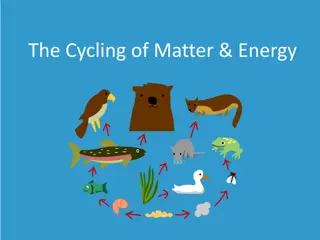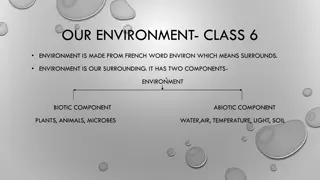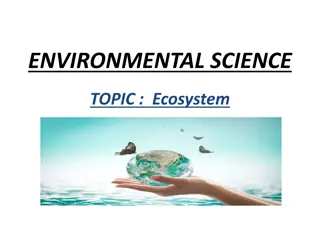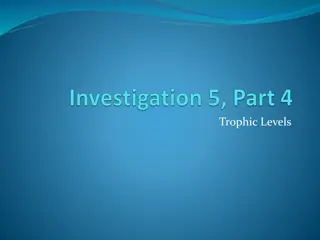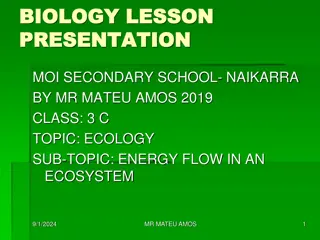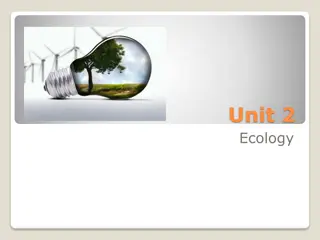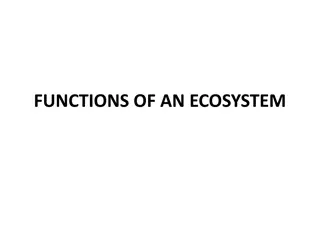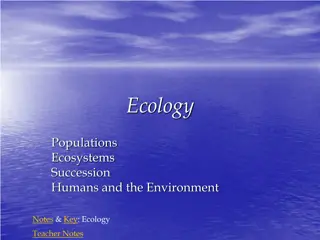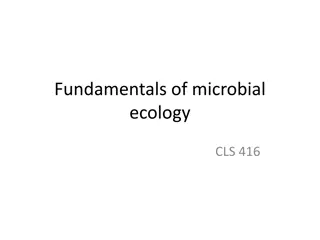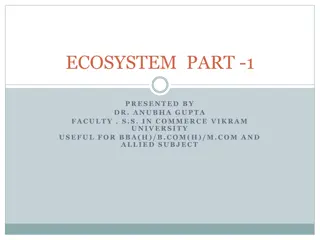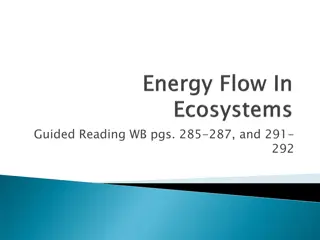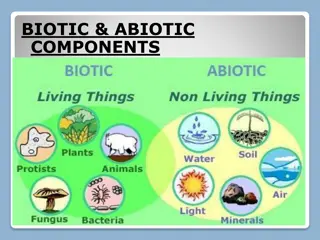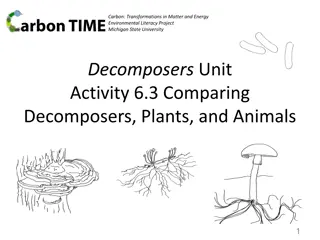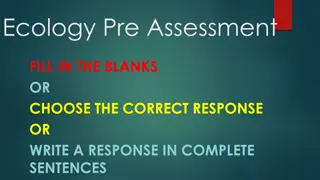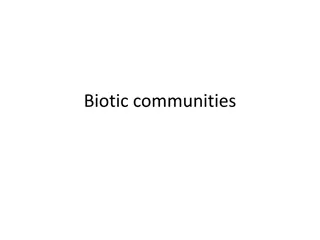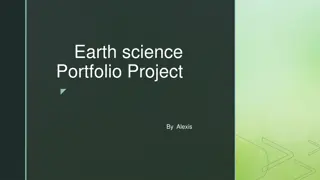Understanding Ecological Relationships and Food Chains
Explore the intricate ecological relationships in nature, including population dynamics, producer-consumer systems, and different types of consumers like herbivores, carnivores, and decomposers. Learn about food chains, food webs, and the interconnectedness of organisms in ecosystems through informa
0 views • 38 slides
Understanding the Cycling of Matter and Energy in Ecosystems
Explore the interconnected web of life within biomes and ecosystems, where organisms play vital roles in maintaining balance. Learn about producers, consumers, and decomposers, and how energy flows through different trophic levels. Dive into the world of primary, secondary, and tertiary consumers, a
0 views • 24 slides
Understanding Our Environment: Class 6 Overview
The environment, derived from the French word "environ" meaning surrounds, encompasses both biotic (living) and abiotic (non-living) components. Biotic components include plants, animals, and microbes, while abiotic components consist of water, air, temperature, light, and soil. Plants are producers
1 views • 9 slides
Fascinating Insights into the Social Life of Termites
Termites, often referred to as white ants, are fascinating insects that play crucial roles in ecosystems. They are adept decomposers, benefiting agriculture by enriching soil. Termites live in large colonies led by a long-living queen, with distinct roles for different members such as workers and so
0 views • 8 slides
Understanding Ecosystems: Structure, Function, and Importance
Ecosystems are diverse and interconnected environments that consist of living and non-living components. This content explores the concept of ecosystems, their structure, functions, and the importance of understanding and preserving them. Topics covered include producers, consumers, decomposers, ene
0 views • 22 slides
Understanding Ecosystems: Structure, Components, and Functions
Ecosystems are intricate units where living organisms interact with each other and the environment. They consist of biotic (living) and abiotic (non-living) components, interrelated in a chain of interactions. Biotic components include autotrophs, heterotrophs, and decomposers, while abiotic compone
0 views • 15 slides
Exploring Trophic Levels and Energy Flow in Ecosystems
Understanding trophic levels and energy flow in ecosystems is vital for comprehending the intricate relationships between producers, consumers, and decomposers. Energy enters the food web through producers, transferring from one trophic level to another. Explore the dynamics of Mono Lake ecosystem a
0 views • 19 slides
Understanding Energy Flow in Ecosystems
Energy flow in ecosystems is vital for sustaining life as it moves through different trophic levels. Primary producers harness solar energy to create organic material, which is then consumed by herbivores, carnivores, and decomposers, forming intricate food chains. Terms like biomass, productivity,
0 views • 8 slides
Understanding Food Chains and Ecosystems in Nature
Explore the interdependence of living organisms in their environment through food chains, trophic levels, and the roles of producers, consumers, and decomposers. Learn how energy flows through ecosystems, the classification of animals based on feeding styles, and the vital role of decomposers in rec
0 views • 34 slides
Understanding Ecosystems: A Beginner's Guide to Ecology
Explore the fascinating world of ecosystems with Mrs. Hart in this informative biology lesson. Discover the components of ecosystems, from biotic to abiotic factors. Learn how energy flows through the ecosystem, with autotrophs producing energy and heterotrophs consuming it. Identify different types
0 views • 33 slides
Understanding Energy Flow in Ecosystems: A Comprehensive Overview
Energy flow in an ecosystem involves the transfer of energy from producers to consumers through different trophic levels, with only a small fraction of energy being passed on at each level. This process is essential for sustaining life within an ecosystem, highlighting the interconnectedness of all
0 views • 11 slides
Understanding Energy Flow in Ecology
Living things require energy to perform functions that keep them alive. This energy is obtained through food consumption, which contains chemical energy stored in molecules. Various processes such as decomposition and synthesis involve energy release and storage in living organisms. Heterotrophs obt
0 views • 18 slides
Understanding the Key Functions of an Ecosystem
Ecosystem functions are vital for the survival of various components within them, with energy flow, nutrient circulation, and biogeochemical cycles playing significant roles. Energy flow starts with solar radiation and sustains producers, consumers, and decomposers, highlighting the interconnectedne
0 views • 21 slides
Understanding Ecology: Populations, Ecosystems, and Relationships
Explore key concepts in ecology including populations, population size and density, dispersion patterns, population growth, habitat and niche relationships, symbiosis, ecosystem energy flow, and roles of producers, consumers, and decomposers.
1 views • 27 slides
Understanding Ecosystems and Global Biomes: A Comprehensive Study
Explore the fascinating world of ecosystems, producers, consumers, and the vital role of decomposers within these intricate systems. Delve into the impact of environmental changes like deforestation on ecosystems. Discover the geographical features and significance of hot deserts, tropical forests,
0 views • 26 slides
Understanding Ecosystems: Definition, Structure, and Function
Ecosystems consist of living and non-living parts forming stable systems. They involve energy flow, nutrient cycling, and interactions between organisms and their environment. Ecosystems vary in abiotic and biotic conditions, with producers, consumers, and decomposers playing key roles. Changes in t
0 views • 13 slides
Understanding Microbial Ecology and Ecosystem Components
Study the diverse relationships of living organisms in their environment, focusing on microbial ecology, ecosystem components, and evolutionary adaptations. Explore the dynamics of abiotic and biotic factors, including producers, decomposers, and consumers, and the types of interactions shaping popu
1 views • 7 slides
Understanding Ecosystems: Components and Interactions
An ecosystem, as explained by Dr. Anubha Gupta from Vikram University, is a community of living organisms and their nonliving environment components working together. The ecosystem comprises biotic and abiotic elements, with producers, consumers, and decomposers playing vital roles in maintaining ba
0 views • 12 slides
Understanding Energy Roles in Ecosystems
Organisms in an ecosystem play essential roles in the movement of energy, with each having a specific function. Energy roles include producers, consumers, and decomposers, each contributing to the balance of energy flow and nutrient cycling. Producers, such as plants, algae, and some bacteria, creat
0 views • 36 slides
Understanding Biotic and Abiotic Components in Ecosystems
Explore the relationship between biotic (living) and abiotic (non-living) components in ecosystems. Learn about the roles of plants, animals, decomposers, and scavengers. Discover the importance of biodegradable and non-biodegradable materials in the environment.
0 views • 21 slides
Understanding the Role of Decomposers in Ecosystems
Exploring the growth, movement, and functioning of decomposers in the environment. Gain insights into how these organisms contribute to nutrient cycling and ecosystem sustainability.
0 views • 7 slides
Ecology Team Trivia: Test Your Environmental Knowledge!
Explore the world of ecology through a fun team trivia game. Discover key vocabulary related to ecosystems, energy roles, and more. Challenge yourself to become the leader of the pack by mastering ecological concepts. Test your knowledge on topics such as abiotic factors, population dynamics, climat
0 views • 43 slides
Ecology Pre-Assessment Questions
This assessment covers topics related to ecology, including food chains, energy pyramids, organism relationships, and ecosystem components. Questions range from identifying correct food chain sequences to defining autotrophs and heterotrophs. Students are prompted to understand how energy flows thro
0 views • 29 slides
Understanding Biotic Communities and Benthic Ecosystems
Living organisms in an area form biotic communities categorized into producers, consumers, omnivores, detrivores, and decomposers. Aquatic organisms such as plankton, benthos, and nekton play vital roles. Benthic communities refer to organisms attached to or burrowing in aquatic ecosystems, influenc
0 views • 17 slides
Exploring the Interconnected World of Owls and Larvae through Earth Science
Discover the intricate relationships between owls, larvae, and their ecosystems in this compelling Earth Science portfolio project by Alexis. Learn about food chains, cellular respiration, endangerment factors, and symbiotic relationships. Gain insights into the role of decomposers, environmental im
0 views • 11 slides

